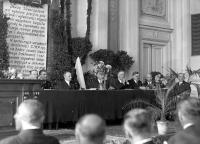Jan Czochralski: father of the world electronics
His discoveries and ideas changed the face of technology. But his life remains a mystery; his story is more like of an adventure fiction character than that of a renowned scientist. What are the things to know about Jan Czochralski?
Read more in the new article in the Research – Innovations – Technology series.
Lifetime’s work
Jan Czochralski is best known for his method of measuring the crystallization speed of metals. Reportedly, the discovery occurred in circumstances which would make for a movie scene. Apparently, immersed in his work, the scientist accidentally put his pen nib in a pot of melted tin instead of an inkwell. Taking the pen out, he noticed a strand of tin hanging from the nib. What is more, Czochralski discovered that the strand was a monocrystal (i.e. a single crystal). And testing such structures brings the most accurate insights about materials.
Czochralski made his discovery in 1916. Importantly, he used that process to obtain single crystals of metals. Only in 1948 did two Americans, Gordon K. Teal and John B. Little, expand the method’s application to non-metals, specifically germanium. This way, the discovery of the Polish scientist started to be used not only in metallurgy but in electronics too. Today, Czochralski process is used to grow single crystal silicon, a material for making diodes, transistors, integrated circuits or chips.
Other notable discoveries
Talking about Czochralski’s work, his other invention must be mentioned in addition to the revolutionary process named after him, i.e. an alloy for sockets used in the manufacture of railway sliding bearings (known as metal B or Bahnmetal). The alloy did not contain the then costly and scarce tin, but used lead instead. It was soft (to lubricate the car axle well) and hard (to prevent fast wear and tear) at the same time. That was an important step in the evolution of railway technology, one advantage of Czochralski’s invention being that contemporary trains could move faster. The scientist patented his invention and later made himself a comfortable living with the money from the patent’s sale to various countries (Germany, the USSR, the USA, Czechoslovakia and Poland).
Czochralski is also an inventor of what is known as a radio microscope, the predecessor of today’s scanning microscopes. The device combined a metallographic microscope and a crystal radio receiver. It allowed checking the composition of metal and alloy samples, with a special focus on the type and distribution of non-metallic substances.
Unusual educational journey
Jan Czochralski graduated from a local high school in his native town of Kcynia, but was so dissatisfied with his marks that, as one story has it, he refused to claim his diploma, or according to another account, he tore up his diploma in front of his teacher. Both versions agree, however, that Czochralski set off to find his fortune in the world without a document of formal qualification. He had already been very keen on chemistry. His carpenter father was allegedly so annoyed with his son’s experiments that he told him to move out.
In 1904, the 19-year-old Czochralski arrived in Germany, first to work at Doctor A. Herbrand’s pharmacy and chemist’s shop in Altglienicke and then at the Kunheim & Co. laboratory in Niederschoenweide near Berlin, and eventually at Allgemeine Elektrizitaets-Gesellschaft (AEG). This is where he gained knowledge and experience. In 1910, he was even awarded an engineering degree from the Technical University of Charlottenburg, a town outside Berlin at the time, although, formally, he could not even be admitted into student ranks because of his missing high school diploma.
Complicated life
Despite his thriving career in Germany, Czochralski decided to return to Poland in 1928. A chemist himself, Ignacy Mościcki, who had risen to President of Poland by then, played a role by persuading the scientist to come back to the homeland. Czochralski received tenure at the Warsaw University of Technology. The Chair of Metallurgy and Metal Science was opened at the Faculty of Chemistry especially for him.
The scientist’s successful life was tarnished by suspicions that surrounded him at the end of World War II. The Professor was accused of collaborating with the enemy; among other allegations, the Materials Research Laboratory headed by Czochralski was claimed to have handled assignments for the Nazi army.
As a result, the scholar lost his job and stature in the scientific community. He moved to his native Kcynia where he set up a company manufacturing things such as shoe polish or a hair perm lotion. He died in 1953.
In 2011, he was rehabilitated. This does not clear all doubts around the life and work of that scientist. Dr Paweł Tomaszewski, who penned Czochralski’s biography, notes that the scientist might have worked with the Polish military intelligence already in the interwar period, still before his return from Germany, and shoving him out of the spotlight after WWII was to protect him against repercussions of his conspirational past.
Agnieszka Kapela
Promotion and Information Office
___________
Sources:
Jan Czochralski - uczony, którego technologia zmieniła świat, http://naukawpolsce.pap.pl/aktualnosci/news%2C397664%2Cjan-czochralski---uczony-ktorego-technologia-zmienila-swiat.html, accessed on: October 15, 2018.
Jan Czochralski - wielki odkrywca przywrócony naszej pamięci, https://www.polskieradio.pl/7/179/Artykul/1077913,Jan-Czochralski-wielki-odkrywca-przywrocony-naszej-pamieci, accessed on: October 15, 2018.
Mirosław Nader, Sylwetka Profesora Czochralskiego - przedwojenna i okupacyjna działalność, losy powojenne, http://bcpw.bg.pw.edu.pl/Content/3576/Czochralski_sylwetka.pdf, accessed on: October 15, 2018.
Niebezpieczne życie Jana Czochralskiego, an interview by Anna Gwozdowska, https://www.focus.pl/artykul/niebezpieczne-zycie-jana-czochralskiego, accessed on: October 15, 2018.
Paweł E. Tomaszewski, Jan Czochralski, ojciec cywilizacji elektronicznej, czyli jak "twórczy błąd" zmienił losy świata, http://mowiawieki.pl/templates/site_pic/files/Polskie-osiagniecia-naukowo-techniczne-odcinek-10.pdf, accessed on: October 15, 2018.
Piotr Cieśliński, Sceny z życia patrioty, którego uznano za zdrajcę, http://wyborcza.pl/1,75400,9953629,Sceny_z_zycia_patrioty__ktorego_uznano_za_zdrajce.html?disableRedirects=true, accessed on: October 15, 2018.
Prof. Jan Czochralski, http://www.janczochralski.com/, accessed on: October 15, 2018.








